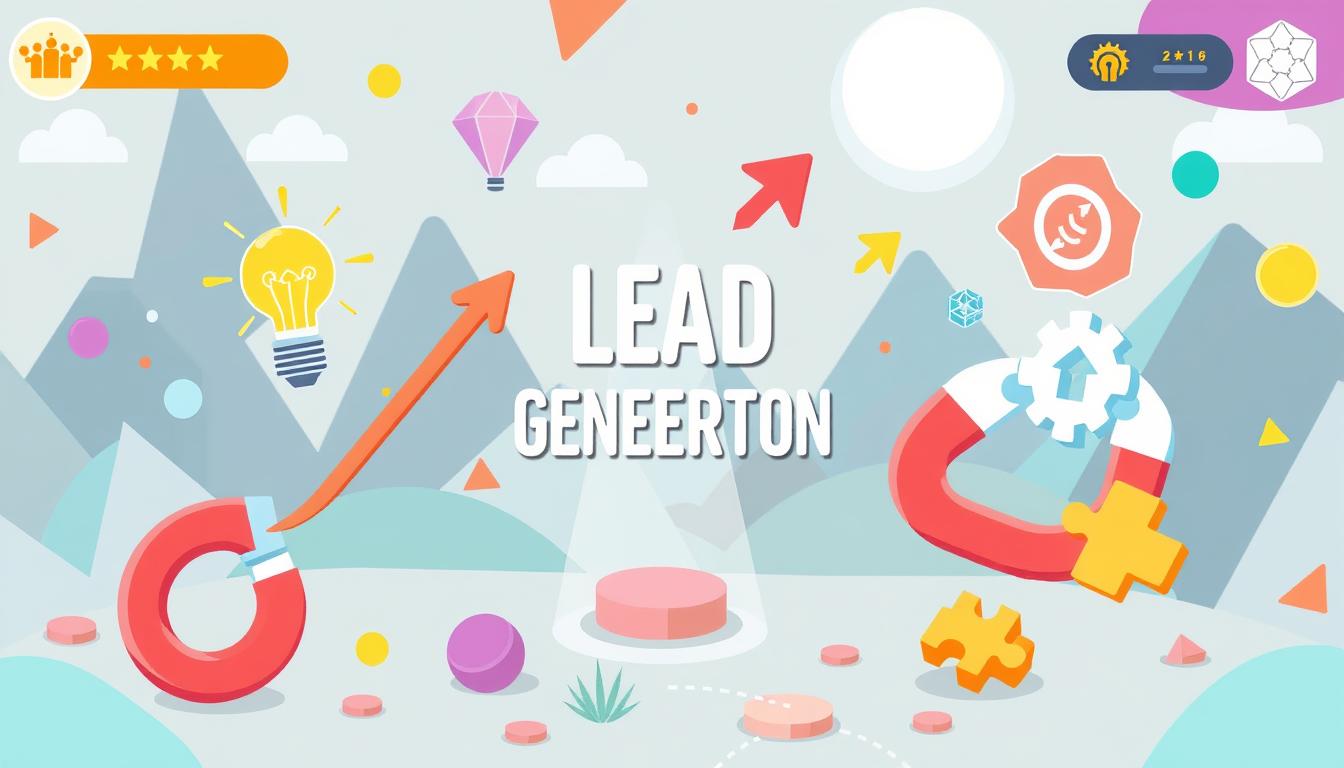In today’s digital world, businesses are always looking for new ways to grab their audience’s attention. They want to get valuable leads. Designing engaging lead generation games is a powerful strategy. These games not only grab users’ interest but also give businesses useful insights and data to improve their marketing.
To make great lead generation games, you need to know your audience well. You should understand their problems and what they like. By using gamification, businesses can make games that are fun and rewarding. This encourages people to play, interact, and eventually, convert into leads. Games can also make the user experience better and add social elements, which are great for marketing teams.
Key Takeaways
- Designing engaging lead generation games can boost user engagement and capture valuable leads.
- Leveraging gamification principles can create immersive and rewarding experiences for the target audience.
- Understanding audience pain points and preferences is crucial for crafting effective lead generation games.
- Incorporating social elements and incentives can foster increased user participation and interactivity.
- Data-driven insights and A/B testing are essential for optimizing lead generation game performance.
How to Design Engaging Lead Generation Games for Your Audience
To make lead generation games that grab attention, you need to know your audience well. Learn about their age, likes, and what they struggle with. This knowledge helps you create games that really speak to them. It’s key for getting people to play and for getting leads.
Understand Your Target Audience
Start by really getting to know who you’re making the game for. Look at their age, gender, hobbies, and how they use the internet. This helps you make a game that fits their style and what they want to see.
Identify Audience Pain Points
Find out what problems your audience faces every day. Use your game to solve these issues. This makes your brand seem like a helpful solution. It also makes people feel good about playing your game.
| Key Audience Insights | Corresponding Game Elements |
|---|---|
| Time-strapped professionals | Quick, bite-sized gameplay sessions |
| Competitive individuals | Leaderboards and challenges |
| Socially-driven millennials | Shareable content and social features |
By really getting to know your audience and solving their problems, you can make engaging lead generation games. These games will draw in users and help your business get more leads.
“The key to creating successful lead generation games is to put yourself in the shoes of your target audience and understand what motivates them to engage and participate.”
The Power of Gamification in Marketing
In today’s marketing world, gamification is a key tool for grabbing attention and boosting engagement. It adds game-like features to lead generation campaigns. This makes the experience fun and memorable, helping businesses connect better with their audience.
Enhance User Experience
Gamification taps into our love for challenges and achievements. By creating lead generation games with rewards and feedback, marketers make the experience enjoyable. This leads to more engagement, loyalty, and better lead capture rates.
Foster Interactivity and Engagement
Interactive content, powered by gamification, gets users involved in marketing. Lead generation games that ask for decisions or puzzles make users part of the brand’s story. This not only boosts engagement but also gives marketers valuable insights to tailor their strategies.
| Gamification Benefit | Impact on Lead Generation |
|---|---|
| Enhanced User Experience | Increased engagement, brand loyalty, and lead capture rates |
| Fostered Interactivity and Engagement | Deeper audience insights and more personalized experiences |
By using gamification marketing, businesses can make interactive content that grabs attention. This leads to better user engagement strategies and more effective lead generation.
Crafting Compelling Interactive Content
Creating high-quality interactive content is key for lead generation games. It’s important to make content that grabs your audience’s attention and keeps them engaged. Designing interactive content that speaks to your audience is vital for success.
Using gamification, like quizzes or puzzles, can make content more fun and engaging. These activities help you understand what your leads like and what they struggle with. By making content both fun and informative, you build a stronger connection with your audience.
Also, adding multimedia like visuals or animations can make your content more engaging. These elements make your content stand out and easier to remember. The goal is to create interactive content that fits your lead generation strategy and adds value to your potential customers.
“Crafting compelling interactive content is not just about creating visually stunning experiences, but also about understanding your audience’s needs and preferences to deliver meaningful engagement.”
By focusing on user engagement strategies and creating valuable content, you can grab your audience’s attention. This drives them further into your lead generation funnel, helping you convert more leads into loyal customers.
User Engagement Strategies for Lead Generation Games
Creating engaging lead generation games is more than just good visuals and fun gameplay. To really get users involved and get valuable leads, businesses need smart strategies. Two key ways to boost success are by offering rewards and adding social features.
Incentivize Participation
Offering great rewards is a proven way to get more people playing your games. With prizes, discounts, or special content, you can get players to share their info and invite friends. This not only brings in more leads but also makes your brand exciting and anticipated.
Incorporate Social Elements
Adding social features to your games can really help. Leaderboards, co-op modes, and sharing options let players compete, work together, and show off. This meets our need for social validation, leading to more playing and more leads.
| User Engagement Strategies | Benefits |
|---|---|
| Incentivize Participation |
|
| Incorporate Social Elements |
|
By using these smart tactics, businesses can make the most of their lead generation games. This leads to more playing, more leads, and better marketing results.
Lead Capture Techniques for Conversion Optimization
In the world of lead generation games, knowing how to capture leads is key. By using smart strategies, marketers can turn players into valuable leads. This opens the door to successful conversions. Let’s look at two top methods: gated content and progressive profiling.
Gated Content and Lead Forms
Gated content is a top tactic for capturing leads. It offers valuable resources like e-books or whitepapers in exchange for contact info. By using a lead form, you can collect important details like name and email. This helps you nurture leads and move them through the sales funnel.
The trick is to make the gated content so good that users can’t resist sharing their info.
Progressive Profiling
Progressive profiling is a step up from gated content. It collects user info gradually, without being too pushy. Instead of asking for everything at once, it breaks it down into smaller steps.
With each interaction or game progress, you can add more details to their profile. This lets you engage with users in a more personalized way and target your marketing better.
Using these lead capture methods can make your lead generation games more effective. The secret is finding the right balance between value, user experience, and collecting data.
“The magic is in the measurement. Carefully tracking the effectiveness of your lead capture techniques is essential for continuous improvement and optimization.”
Audience Segmentation and Personalization
In lead generation games, knowing your audience well is key. Audience segmentation and personalization are crucial. They make your games more relevant, engaging, and boost conversion rates.
Segmenting your audience helps you tailor games to their specific needs. This makes the experience better and builds a stronger bond with your brand.
- Identify key audience segments: Analyze user data to pinpoint the unique characteristics and pain points of different user groups.
- Craft personalized game experiences: Design game mechanics, content, and rewards that align with the specific needs and interests of each audience segment.
- Continuous optimization: Regularly monitor and refine your segmentation and personalization strategies to ensure they remain effective and relevant.
Effective audience segmentation and personalization unlock your games’ full potential. They offer a unique and engaging experience. This grabs your audience’s attention, encourages deeper interactions, and converts more leads into valuable customers.
“Personalization is no longer a nice-to-have – it’s a must-have in today’s competitive landscape. By understanding and catering to the unique needs of your audience, you can create an unbeatable lead generation strategy.”

Incentive-Driven Campaigns for Maximum Impact
In the world of lead generation games, the power of incentive-driven campaigns is huge. By offering great rewards and creating urgency, marketers can get players to join and convert. This helps make their lead generation efforts much more effective.
Offer Compelling Rewards
Rewards are key to any good incentive-driven campaign. When making your lead generation game, find rewards that really speak to your audience. These can be things like:
- Exclusive discounts or coupons
- Gift cards or merchandise
- Access to premium content or features
- Entries into a larger prize drawing
By matching rewards to what your audience wants, you create excitement and anticipation. This drives them to play your game and share their info.
Create a Sense of Urgency
Adding urgency to your campaign is also very effective. Use limited-time offers, scarcity-based promotions, or countdown timers. This taps into our natural urge to act before it’s too late. It’s a great way to get players to join and complete actions to get their rewards.
By mixing great rewards with a sense of urgency, you create campaigns that really grab your audience’s attention. This drives maximum impact for your lead generation efforts.
Data-Driven Insights and A/B Testing
In the world of lead generation games, data and A/B testing are crucial. They help marketers understand what their audience likes and needs. This knowledge lets them make the game better, catch more leads, and boost conversion rates.
A/B testing is key in data-driven marketing. It lets marketers try out different parts of the game, like how it looks or what players can do. By seeing which versions work best, they can make the game even more effective.
- Leverage data-driven insights to understand user behavior and preferences
- Implement A/B testing to continuously improve game elements and lead capture techniques
- Utilize conversion optimization strategies to drive higher engagement and conversions
| Metric | Original Game | A/B Test Variation | Improvement |
|---|---|---|---|
| Lead Capture Rate | 15% | 22% | +47% |
| Average Time Spent | 3.2 minutes | 4.6 minutes | +43.8% |
| Conversion Rate | 8% | 12% | +50% |
By using a data-driven and A/B testing approach, marketers can keep making their games better. They ensure the game is fun and effective, meeting the needs of their audience and boosting conversion optimization results.

“The more you know, the more you can optimize. Data-driven insights are the foundation for creating truly impactful lead generation games.”
Conclusion
Designing engaging lead generation games is a great way to boost user engagement and capture leads. It’s also a key to marketing success. By knowing your audience and their needs, you can create fun, interactive content.
Using strategies like incentives and social elements can make your content more engaging. You can also use techniques like gated content and progressive profiling to capture leads. This article has given you a solid plan to improve your lead generation.
Remember, always keep improving your game design based on what your data shows. A focus on your users and data will help you create games that attract and engage your audience. This will take your marketing to new levels.
FAQ
What is the purpose of designing lead generation games?
Lead generation games aim to boost user engagement and capture qualified leads. They use gamification and interactive content to engage the audience. This approach helps convert them into valuable leads.
How can understanding the target audience help in designing effective lead generation games?
Knowing your audience is key to creating games that resonate with them. By understanding their needs and interests, you can craft games that solve their problems. This makes the experience compelling and encourages participation.
What are the benefits of incorporating gamification into lead generation strategies?
Gamification makes marketing more engaging and interactive. It adds rewards and challenges that capture the audience’s attention. This leads to higher engagement and more leads.
How can interactive content improve the effectiveness of lead generation games?
Interactive content is essential for lead generation games. It should be visually appealing and engaging. This draws in the audience and encourages them to participate, boosting engagement and lead capture.
What user engagement strategies can be leveraged in lead generation games?
To engage users, offer rewards and create a sense of community. This fosters competition and drives engagement. It also increases lead conversion rates and makes the experience memorable.
How can lead capture techniques be integrated into lead generation games?
Use techniques like gated content and lead forms in games. Place these elements strategically to gather valuable user information. This turns engaged players into qualified leads for your business.
Why is audience segmentation and personalization important in lead generation games?
Segmenting and personalizing the game experience is crucial. It allows you to tailor the game to specific user groups. This improves relevance, boosts engagement, and increases conversion rates.
What are the benefits of using incentive-driven campaigns in lead generation games?
Incentive-driven campaigns boost player participation and conversion. They offer rewards and create urgency. This motivates players to engage and take desired actions, maximizing lead generation.
How can data-driven insights and A/B testing improve lead generation game performance?
Collect and analyze data, and conduct A/B testing to optimize game performance. This helps refine the game experience and lead capture techniques. It drives higher conversion rates through informed adjustments.


